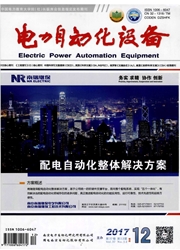

 中文摘要:
中文摘要:
多级磁阀结构的提出在一定程度上有效减小了磁控电抗器输出电流的谐波含量,但也引入了磁阀的级数和磁阀尺寸的优化、电抗器容量变化及结构设计制造复杂等一系列问题。一方面,从磁控电抗器的磁阀结构出发,详细建立了n级饱和磁阀式可控电抗器的磁化特性、电流特性的数学模型,在此基础上,对采用准优化、面积渐变、半径渐变和优化4种设计方法的n级饱和磁阀式可控电抗器,从谐波、容量、结构复杂度等多方面进行综合分析,确立了相对最优的磁阀级数与尺寸设计方案。另一方面,研究了n级饱和磁阀式可控电抗器主要参数之间的关系,同时指出其在MATLAB中仿真模型的参数设计方法。仿真结果验证了所给出的n级饱和磁阀式可控电抗器仿真方法的有效性及结构特性分析结论的正确性。
 英文摘要:
英文摘要:
Though the multi-stage structure of magnetic valve quite effectively reduces the harmonic contents of MCR(Magnetic-valve Controllable Reactor) output current,it introduces a series of defects,such as stage number and size optimization,rated capacity change,complex structure,etc. The mathematical models are established for the magnetic and current properties of n SMCR(n-stage Saturable MCR) according to the multi-stage structure of magnetic valve,based on which,the harmonic currents,rated capacity and structure complexity of n SMCR are comprehensively analyzed for four design schemes,i.e. quasi optimization,area gradient,radius gradient and optimization,and the relatively optimal design scheme of its stage number and size is determined. The relationship among the main parameters of n SMCR is researched and the parameter design of MATLAB simulation model is given. The simulative results confirm the effectiveness of the proposed simulation method and the correctness of structure property analysis.
 同期刊论文项目
同期刊论文项目
 同项目期刊论文
同项目期刊论文
 Simulation Analysis for Controllable Reactor of Transformer Type with Multifold Magnetic Materials I
Simulation Analysis for Controllable Reactor of Transformer Type with Multifold Magnetic Materials I Magnetic Integration Technology in Controllable Reactor of Transformer Type Constituted by Various M
Magnetic Integration Technology in Controllable Reactor of Transformer Type Constituted by Various M Winding Current Utilization Calculation of Controllable Reactor of Transformer Type Based on Equival
Winding Current Utilization Calculation of Controllable Reactor of Transformer Type Based on Equival 期刊信息
期刊信息
